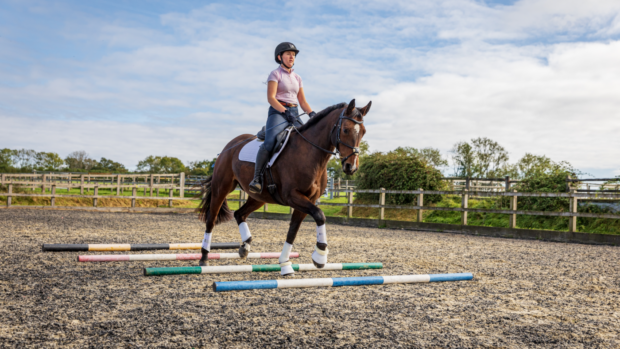The success show rider uses pole exercises for horses to add something new to training, while improving self-carriage, balance and both upward and downward transitions
Aim
While I like to use these schooling exercises on a regular basis, I also do a lot of work with the horses out hacking, working on transitions and lateral movements.
By keeping the horses out of the school, I find that work doesn’t become a chore for them and they’re being educated and exposed to new experiences daily.
When in the school, I start loosening up the horses, working off the tracks, and I like to have them going forward long and low, but off their shoulder. While polework exercises can help balance and self-carriage, they can also improve your horse’s suppleness, responsiveness to your aids and transitions.
Remember that young and inexperienced horses may find these exercises hard, so it’s important not to ask too much too soon.
The exercise

1. When I start these two exercises, I like to have six ground poles placed approximately three metres apart from each other (see diagram one).
2. Once you’ve warmed up your horse, start the exercise by riding a serpentine at the walk, keeping the outline long and low.
3 When you start turning the horse through the poles, do so using your legs, rather than a lot of rein. Keep as close to the poles as possible.
4. Depending on your horse’s level of training, you can move up to trot when you’re feeling confident to do so.
5. When you’ve mastered the first stage of the exercise, start between poles three and four and halt. When you move off, make sure your horse
is long and low, and listening to your leg aids.
6. Introduce a trot circle around the poles one way, trying not to create too much inside bend, then return to poles three and four and halt again (see diagram two).
7. Change the rein and ride another circle, then back to halt between poles three and four. Repeat the exercise until you’re confident that the horse is listening to all the correct aids.
8. This can also be done riding canter to walk, once you have mastered it in trot. Do these exercises according to the horse’s stage of training and fitness, alongside free, forward movement in the school.
Tips and pitfalls
- Make sure your horse is warmed up correctly and listening to you before starting, in order to get the most out of the exercises.
- You shouldn’t do these exercises too often. Once the horse has done what is asked of him, give him praise and move on to something new — it’s always best to finish on a good note.
- When I’m doing the second stage of the exercise, I aim to ride it as a 50p coin rather than constantly turning on the circle, as this enables the horse to balance himself.
You might also be interested in:

#SundaySchool: Dan Greenwood on improving suppleness (after lockdown lifts)
The grand prix dressage rider discusses using turn on the forehand to improve suppleness and refine the horse’s understanding of

#SundaySchool: Laura Tomlinson — how to develop your horse’s self-carriage (after lockdown lifts)
Olympic dressage rider Laura Tomlinson explains how to improve a horse’s self-carriage and what it means to do so

Subscribe to Horse & Hound magazine today – and enjoy unlimited website access all year round





